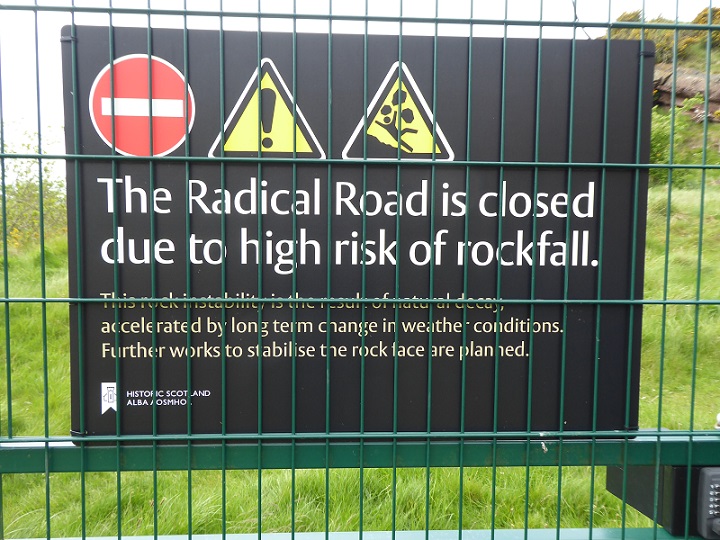
Rather like with telecommunications masts (see here), a number of organisations have come together to try and persuade Historic and Environment Scotland (HES) to re-open the Radical Road in Edinburgh which was closed after rockfall in September 2018. After a series of meetings with HES in 2022, the organisations were given the impression that the Radical Rd would be included in a consultation on a new management plan for Holyrood Park starting in the Autumn of 2022. A year later nothing had happened so on 11th September 2023, the fifth anniversary of the “temporary” closure, the organisations went public calling on HES to act (see here).
Two weeks later, miraculously, HES launched a 13 week consultation called “A new future for Edinburgh’s Holyrood Park” (see here).
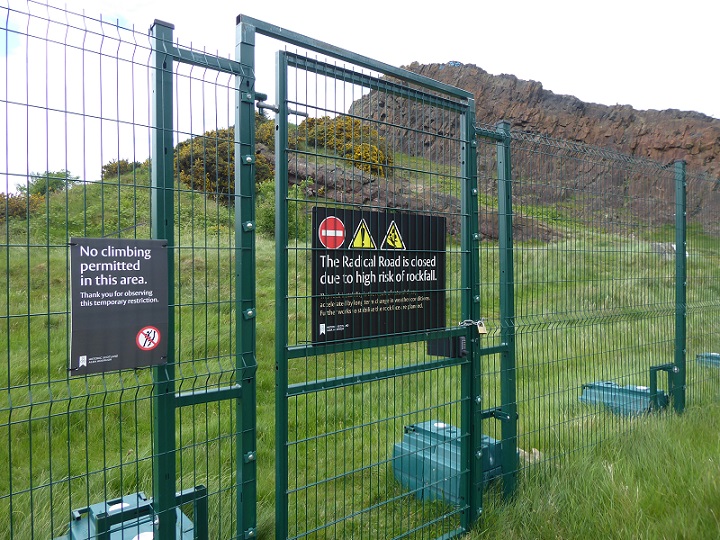
In early November the five organisations (The Edinburgh Geological Society, Mountaineering Scotland, Scotways, Ramblers Scotland and the Cockburn Association) advertised a public meeting for 3rd December on “The Radical Road Past, Present, Future?” (see here). HES were invited but then on 30th November announced they were holding their own event the day before, on the 2nd December and at the same venue (see here)! Petty and pathetic!

It appears from the publicity for that event that HES is now thinking of charging people for the opportunity of being able to express their views (why else would there be a “FREE” drop-in session?).
At the campaign meeting on Sunday – HES had declined the invitation to attend – I was tempted to suggest from the floor that if those present just went up and removed some of the fencing maybe HES would copy them and take the rest down!
The campaign to re-open the Radical Road
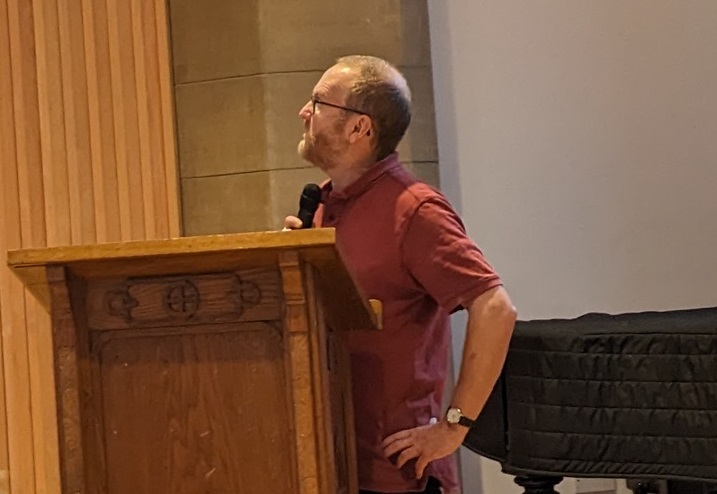
Almost everyone at the meeting expressed frustration and anger at HES’ actions in closing the Radical Rd, the lack of consultation and engagement since then and wanted the road re-opened. Most people recognised, as I explained here back in 2021, that Scottish Ministers needed to review the Holyrood Park Regulations to bring them into line with access rights. Interestingly, several people suggested that HES were unfit to manage outdoor spaces and Scottish Ministers should transfer the responsibility and funding for Holyrood Park to another body.
The need for a stronger campaign involving people was recognised and the day after the meeting Ramblers Scotland, on behalf of the five organisations, launched a petition demanding the Radical Road to be re-opened to take to HES (see here). Please consider signing and sharing it, there are already over 550 signatures. While I doubt HES will take much notice, the next step could be to take a petition to the Scottish Parliament’s petitions committee asking them to address the access problem on their doorstep.
The campaign is also asking people to respond to HES’ “survey” (see here), on what they claim is an “Outline Strategic Plan” for Holyrood Park, before it closes on Tuesday 19th December.
The outline plan and its accompanying appendices are the usual vacuous policy spin, with lists of national and local “policy drivers”, references to outcomes and the importance of “partnership” (ironic that!) and the use of all the fashionable jargon. Here is a flavour:
“All this will be delivered by partnership between the people of Edinburgh and key organisations. Working together to deliver an exemplar of landscape management that fully integrates communities, with climate resilience, economic benefit and natural and historic conservation. Creating a Climate Positive asset for Edinburgh, Scotland and the Planet.”
Wading through all this documentation is a thankless task but thankfully the campaign produced for the meeting some advice on how to respond to the survey which I have uploaded here. In my view, however, this advice does not go far enough: if the recommendation to put people first is to have any meaning then we, the people, should be able to exercise our access rights on the same basis as everywhere else in Scotland. I would urge anyone who is responding therefore not only to demand that the Radical Road be re-opened – its hardly mentioned in the consultation – as the campaign suggests but that the Holyrood Park regulations be repealed.
Understanding HES’ failure to undertake any meaningful consultation on the Radical Rd
After my last post (see here) on the Radical Rd 18 months ago, which considered HES’ health and safety obligations, I was made aware that HES had adopted a policy document “Management of Access to Properties in Care” in 2016 (see here).
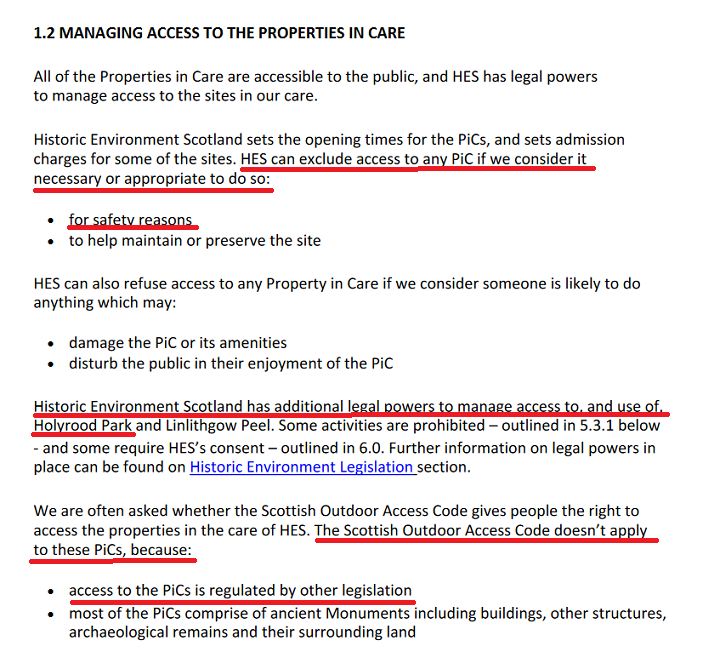
This policy conflates the law on two different things, access to buildings and access to open spaces like Holyrood Park, and the reasons why the Scottish Outdoor Access Code (SOAC) is not applicable to the properties in HES’ care.
In the case of buildings this is because under the Land Reform (Scotland) Act 2003 buildings and their curtilage are exempt from access rights. This means that SOAC could NEVER apply to buildings in HES’s care. Access to Holyrood Park is quite different. The expectation of the Scottish Parliament when debating and passing the Land Reform Act was that access rights would apply to almost all open spaces, including city parks. Indeed the draft legislation was amended to include Balmoral so why not also include what was once a Royal Park? As a consequence of the Act most byelaws and management rules were reviewed or repealed in the years following 2003. However, access to Holyrood Park, which was controlled by parliamentary regulations not byelaws, was inexplicably left out of the process.
The statement in HES’ policy that they have “additional powers to manage access to, and use of, Holyrood Park” is therefore wrong. The powers are NOT “additional”. Without the Holyrood Park Regulations HES could not have taken the decision to close the Radical Rd by itself but legally would have had to have sought a Section 11 Order under the Land Reform (Scotland) Act 2003. That would have required extensive consultation and any exemption lasting more than 6 days would have required the assent of Scottish Ministers.
Last year I asked HES what information and correspondence they had had with the Scottish Government about the Holyrood Park Regulations. They refused to provide the legal advice, using an exemption clause in the Freedom of Information Scotland Act, but provided other correspondence about increasing car parking charges which, under the Holyrood Park Regulations, had been fixed at £1. This was actually quite revealing of HES’s position.
The management-speak in the first paragraph is entertaining – the closure of the Radical Rd neither balanced, rational nor proportionate! – but the second is what is important here:
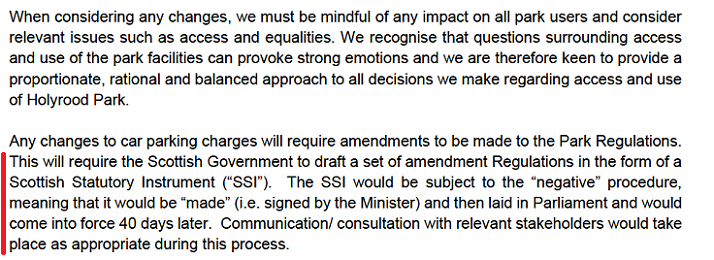
This extract shows the Holyrood Park regulations would not be difficult to amend and that if this is being considered to increase parking charges it could be done for access rights. If HES won’t ask the Scottish Government to do this, the campaign and politicians should!
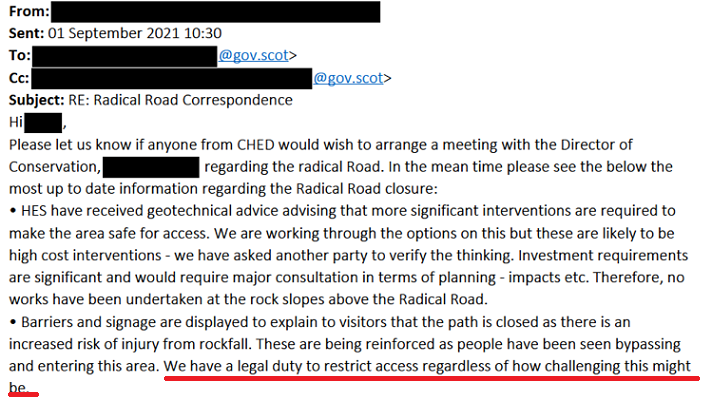
The last sentence is completely wrong. As I explained here HES has no legal duty to restrict public access, either under Health and Safety legislation (which applies to employees) or under the Occupiers Liability Act. Nor is there anything in the Holyrood Park Regulations which creates further health and safety obligations above those contained in those two pieces of legislation.
After HES had provided this information, I asked them to clarify what had been redacted and the justification for all the redactions under the Environmental Information Regulations. HES’ response (see here for their letter) clarified that none of the redacted “correspondence related to how the Holyrood Park Regulations fit with the Land Reform (Scotland) Act 2003”. In other words it appears HES has never asked the Scottish Government to review the Holyrood Park regulations so that access rights apply.
HES’ review also found that;
“there was one sentence in one document that I reviewed that I consider is relevant to your concerns. I have taken the view, exceptionally [!], that this should be disclosed. The sentence states “The general “right to roam” under the Scottish Outdoor Access Code does not apply in the Park to the extent that access to the Park is prohibited, restricted, or excluded in terms of the Regulations or the 1979 Act””.
That confirms the problem is the Holyrood Park Regulations which grant HES enormous powers and enables them to ignore the provisions of the Land Reform (Scotland) Act.
Another email confirms that this suits them:
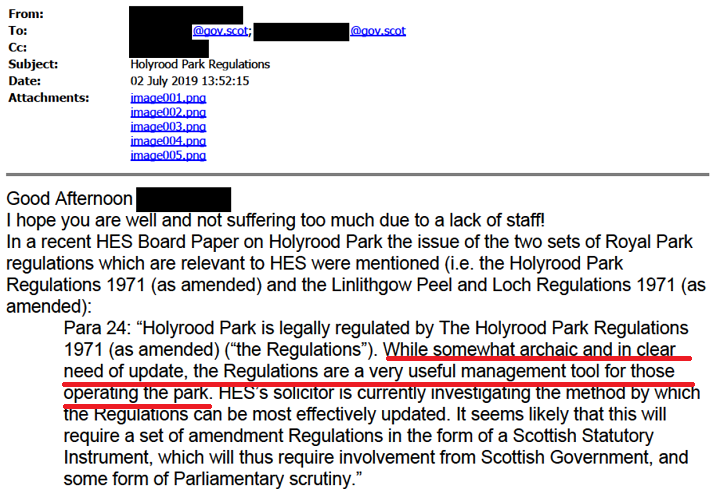
The Regulations are a “very useful management tool” precisely because they enable HES to ignore the legal framework for access which applies to the rest of Scotland and ignore public opinion, as they have done now for over 5 years with the Radical Road.
What the campaign should do next
In my view HES will never willingly change and the campaign therefore needs to start focus on putting pressure on the Scottish Government and the Scottish Parliament to act.
Should the Scottish Minister responsible for HES, Christina McKelvie, be concerned about being held liable for some park user being hit by a falling rock, she could clarify the law in Scotland as they did in England in the Marine and Coastal Act 2009. Clause 305 of that act (see here) restricts the liability of the Secretary of State and Natural England if they fail to put up signs warning people of natural hazards – like rockfall from Salisbury Crags. Clause 306 amends the Occupiers Liability [England] Act 1984 to make it 100% clear that landowners are not responsible “for a risk resulting from the existence of any physical feature”. If there was the will there is a way to enable people to take responsibility for their own actions in the face of natural hazards.
My view is that HES should accept people have the right to make their own judgements about the risks of using the Radical Rd. As I explained in my last post, based on all the work NatureScot did around the law on Occupiers Liability and public access, they could do so without fear of being found liable in the case of an accident (providing some warning signs were in place to advise tourists new to Scotland). There is therefore no strong case for amending the law on Occupiers Liability in respect to public access at the present time. HOWEVER, Scottish Ministers could make it quite clear that, should there be an accident caused by falling rocks and should HES be successfully sued, they will amend the law as in England.
If this approach was adopted there is no reason why the Radical Rd should not be re-opened for 1st January and there is certainly no need to wait for the outcome of the current consultation on the strategic plan for Holyrood Park. What is needed is a bit of leadership, instead of the normal bureaucratic fudges and yet more meaningless policies and plans, and some practical action.
Is the A83 going to be closed for public access for the same reasons? Or for that matter any other roads that suffer from or have suffered from landslides?
Don’t give them ideas!
There is a road in Derbyshire which has been closed for months due to a landslip, but is still open to walkers and cyclists. Various bodies are keen to leave it that way, people who actually live there not so much.
Every day great people walk down canyons of masonry (streets) where stone ‘could’ fall off without notice, indeed these canyons are often topped by particularly lethal stones (slates) as sharp as knives.
By far the best people to assess the risk of falling rocks would be the climbing community. Their risk-taking is practical and personal, and would be free. No consulting engineer could do this as well.
Fortunately there is n0 record of anyone has been crushed to death on the Radical Road, though sadly many have had fatal slips on the top of Arthur’s Seat in poor conditions.
Our local woodland was “closed” by the local authority becasue a tree survey had found some rotten trees that might have fallen on people. The people simply ignord the signs and kept on walking. What offence would be committed if the fencing was removed and people started walking?
A good question Geoff. Damaging or taking the fence away would be offences but if the fence could be opened without damaging it it may well be no offence would be committed. I need to investigate further but the Holyrood Park Regulations stem from the Parks Regulation Act 1872, much of which has been amended/repealed, but still gives Park Keepers the same power as a police constable. The section of that Act which provides for breaches of the regulations to be treated as summary offences was repealed in 1993.